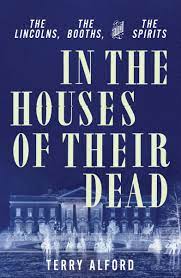Terry Alford
Liveright Publishing Company

|
John (Wilkes Booth) wandered down to the caravan, where he found an old woman to tell his fortune. “Ah, you’ve a bad hand,” the crone commenced. “Trouble in plenty everywhere I look. You’ll break hearts. They’ll be nothing to you. You’ll die young and leave many to mourn you, many to love you, too.” Taken aback, John asked if his destiny was unchangeable. “You’re born under an unlucky star,” she informed him. “…A fast life, short but a grand one.” “It is a good thing it is so short as it is so bad a fortune. For this evil dose you expect me to cross your palm?” asked John. “Young sir, I’ve never seen a worse hand, and I wish I hadn’t seen it…” from In the Houses of Their Dead |
The metaphysical itch that can't be scratched
What we believe is often what we want to believe, where facts become accessories to those beliefs and largely decorative. This accounts for how, say, we can look at a former US president and have such starkly different beliefs about the man (I’m speaking, of course, about Thomas Jefferson—Man of the Enlightenment or paternalistic racist?)
Spiritualism as a belief system swept the United States in the mid-nineteenth century, beginning in 1848, when Margaret and Kate Fox demonstrated an ability to communicate with the dead. They became a sensation, embarking on a lecture tour and sparking a national phenomenon: séances became popular, mediums proliferated, people found they, too, could channel the spirits of the dead—and all without the internet! (Years later, the Fox sisters confessed they were frauds, and launched a new lecture tour exposing charlatans and frauds--Ya gotta admire Americans’ ability to re-invent themselves.)
The White House was not immune to the spiritualist craze, argues Terry Alford, professor emeritus of history at Northern Virginia Community College. The séances in the Lincoln White House were seen by many as “just another quirk of (the) quirky First Lady,” for underlying spiritualism’s popularity was the desire to believe—in the immortality of the soul; in the continuation of consciousness after the death of the body; that the dearly departed are still with us on some non-physical plane.
This was certainly the case with the president and Mary Todd Lincoln, who lost their beloved son, Willie, in 1862 from typhoid fever. Grief stricken, they reached out to various mediums, those “halfway between the earthly and spiritual planes of existence.”
Alford suggests that Lincoln was a superstitious man, a fatalist who saw himself and others living under the hand of Fate. Along with the Lincolns, he tells the story of the equally superstitious Booth family, especially patriarch Junius, once the most famous actor in the country, and his actor sons, Edwin and John Wilkes. But what makes Alford’s account particularly intriguing is the way these two families’ destinies continued to cross: Edwin Booth would save the life of Lincoln’s oldest son Robert; a medium to the First Family who warned Lincoln of his death was also a close friend of John Wilkes Booth; after being shot, Lincoln was carried from Ford’s Theater across the street to the home of William Petersen and placed on a bed that John Wilkes had slept in a few weeks earlier.
We are the only animal who lives by beliefs as much as by bread. Experience shows that beliefs don’t need to be true; they only need to satisfy some deeper need. Among those needs is the yearning to know the unknowable. It is the metaphysical itch that can’t be scratched. So we settle for belief.
This review first appeared in The Columbia River Reader (September 15, 2022.) Reprinted with permission.



